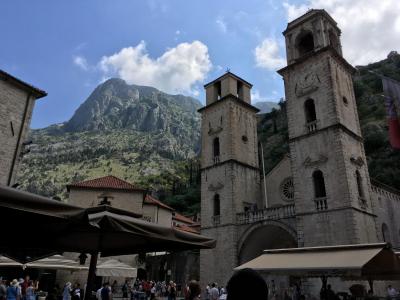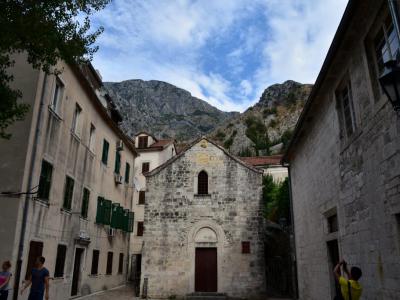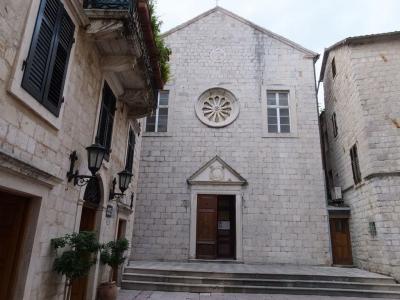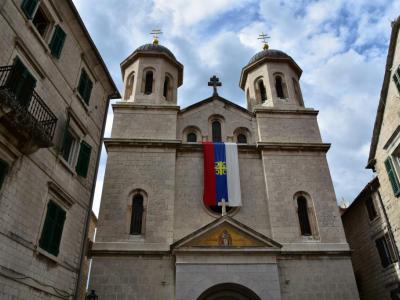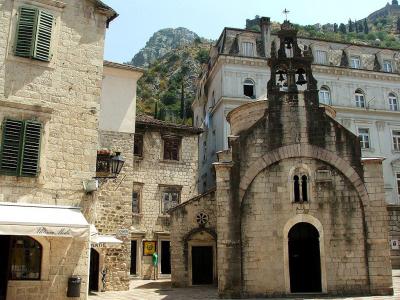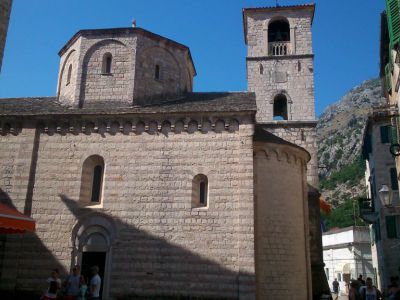
Kotor's Historical Churches Walking Tour (Self Guided), Kotor
Kotor, a picturesque coastal town in Montenegro, albeit small, nonetheless, boasts a surprising number of historical churches that beautifully reflect its centuries-old heritage. Many of these temples are richly decorated with frescoes, some dating as far back as the 1300s.
At the heart of the town lies Saint Tryphon Square dominated by the eponymous cathedral, an iconic landmark from the 12th century. This majestic temple showcases Romanesque and Byzantine architectural influences and is dedicated to the patron saint of Kotor.
Venturing through the winding streets further, one can see the charming Church of Saint Michael. Built in the 14th century, this quaint church exudes a serene ambiance, inviting visitors to explore its intimate interior adorned with exquisite frescoes and ornate altars.
Further exploration reveals the elegant Church of Saint Clara, a hidden gem tucked away in the labyrinthine alleys of Kotor. Dating back to the 14th century, this diminutive church captivates with its simple yet graceful design, offering a peaceful retreat from the outside clamor.
Continuing the journey of discovery, visitors encounter the enchanting Church of Saint Nicholas, a sublime example of Byzantine architecture from (you'll be surprised!) the early 20th century.
As one explores Kotor's historical churches, one cannot miss the lovely Church of Saint Luke, a splendid testament to medieval craftsmanship. Dating back to the 12th century, this venerable church captivates with its elegant stone façade and exquisite frescoes depicting scenes from religious lore.
Finally, the journey culminates at the idyllic Church of Saint Ozana, also known as Saint Maria of River. Nestled amidst lush greenery along the waterfront, this charming church offers a serene retreat for contemplation and spiritual rejuvenation.
Kotor's historical churches stand as timeless monuments to the town's cultural and spiritual legacy. History enthusiasts and architecture aficionados alike will surely be captivated by the beauty that abounds in these sacred sites. If you wish to experience the allure of Kotor's religious scene, join this self-guided tour that will take you through centuries of faith and tradition.
At the heart of the town lies Saint Tryphon Square dominated by the eponymous cathedral, an iconic landmark from the 12th century. This majestic temple showcases Romanesque and Byzantine architectural influences and is dedicated to the patron saint of Kotor.
Venturing through the winding streets further, one can see the charming Church of Saint Michael. Built in the 14th century, this quaint church exudes a serene ambiance, inviting visitors to explore its intimate interior adorned with exquisite frescoes and ornate altars.
Further exploration reveals the elegant Church of Saint Clara, a hidden gem tucked away in the labyrinthine alleys of Kotor. Dating back to the 14th century, this diminutive church captivates with its simple yet graceful design, offering a peaceful retreat from the outside clamor.
Continuing the journey of discovery, visitors encounter the enchanting Church of Saint Nicholas, a sublime example of Byzantine architecture from (you'll be surprised!) the early 20th century.
As one explores Kotor's historical churches, one cannot miss the lovely Church of Saint Luke, a splendid testament to medieval craftsmanship. Dating back to the 12th century, this venerable church captivates with its elegant stone façade and exquisite frescoes depicting scenes from religious lore.
Finally, the journey culminates at the idyllic Church of Saint Ozana, also known as Saint Maria of River. Nestled amidst lush greenery along the waterfront, this charming church offers a serene retreat for contemplation and spiritual rejuvenation.
Kotor's historical churches stand as timeless monuments to the town's cultural and spiritual legacy. History enthusiasts and architecture aficionados alike will surely be captivated by the beauty that abounds in these sacred sites. If you wish to experience the allure of Kotor's religious scene, join this self-guided tour that will take you through centuries of faith and tradition.
How it works: Download the app "GPSmyCity: Walks in 1K+ Cities" from Apple App Store or Google Play Store to your mobile phone or tablet. The app turns your mobile device into a personal tour guide and its built-in GPS navigation functions guide you from one tour stop to next. The app works offline, so no data plan is needed when traveling abroad.
Kotor's Historical Churches Walking Tour Map
Guide Name: Kotor's Historical Churches Walking Tour
Guide Location: Montenegro » Kotor (See other walking tours in Kotor)
Guide Type: Self-guided Walking Tour (Sightseeing)
# of Attractions: 6
Tour Duration: 1 Hour(s)
Travel Distance: 0.5 Km or 0.3 Miles
Author: emily
Sight(s) Featured in This Guide:
Guide Location: Montenegro » Kotor (See other walking tours in Kotor)
Guide Type: Self-guided Walking Tour (Sightseeing)
# of Attractions: 6
Tour Duration: 1 Hour(s)
Travel Distance: 0.5 Km or 0.3 Miles
Author: emily
Sight(s) Featured in This Guide:
- Saint Tryphon Cathedral and Square
- Crkva sv. Mihaila (Church of St. Michael)
- Crkva sv. Klare (Monastery and Church of St. Clare)
- Church of St. Nicholas
- Church of St. Luke
- Crkva sv. Marije Koledate (Church of St. Mary Collegiate)
1) Saint Tryphon Cathedral and Square (must see)
Another one of the main squares of old town Kotor, Saint Tryphon's, is home to the Saint Tryphon Cathedral. Since it is one of the most impressive and imposing buildings in the city, it is also sometimes called the Kotor Cathedral.
The cathedral stands out in this historic city as it embodies the tumultuous past of the area. The site began in 809 when Venetian merchants brought artifacts back from Constantinople.
A local citizen built a church here for exhibiting the relics, and this church was mentioned in the writings of Byzantine Emperor Constantine VII Porphyrogenitus. Those writings were the only evidence of that first church until archaeological researchers found new evidence in 1987.
The cathedral was completed in 1166 and was built in the Romanesque and Byzantine styles. Like many of the structures in town, it was severely damaged by many earthquakes over the centuries. With each repair and restoration, the style of the building changed. Occasionally rebuilt would uncover elements of the original building.
It wasn't until the 1979 earthquake that the building was reconstructed to preserve the original 1166 structure.
Inside, a Ciborium from 1362 dominates the cathedral. You'll also see many paintings from medieval times. There is also a reliquary that has many relics from the 15th through the 18th centuries.
There are other important structures located on the square in front of the cathedral, as well. The Bishop Palace was the official residence of the bishops and is located adjacent to the cathedral. It was owned by the noble family Drago, whose palace is also on the square.
The cathedral stands out in this historic city as it embodies the tumultuous past of the area. The site began in 809 when Venetian merchants brought artifacts back from Constantinople.
A local citizen built a church here for exhibiting the relics, and this church was mentioned in the writings of Byzantine Emperor Constantine VII Porphyrogenitus. Those writings were the only evidence of that first church until archaeological researchers found new evidence in 1987.
The cathedral was completed in 1166 and was built in the Romanesque and Byzantine styles. Like many of the structures in town, it was severely damaged by many earthquakes over the centuries. With each repair and restoration, the style of the building changed. Occasionally rebuilt would uncover elements of the original building.
It wasn't until the 1979 earthquake that the building was reconstructed to preserve the original 1166 structure.
Inside, a Ciborium from 1362 dominates the cathedral. You'll also see many paintings from medieval times. There is also a reliquary that has many relics from the 15th through the 18th centuries.
There are other important structures located on the square in front of the cathedral, as well. The Bishop Palace was the official residence of the bishops and is located adjacent to the cathedral. It was owned by the noble family Drago, whose palace is also on the square.
2) Crkva sv. Mihaila (Church of St. Michael)
Saint Michael's Church stands as a testament to centuries of history, with its origins tracing back to the early Christian era. Originally built in Romano-Gothic style at the end of the 13th century, it stands upon the foundations of a 12th-century Romanesque church, which itself was erected on the remains of a 6th-century basilica. In the mid-15th century, a distinctive bell tower in the shape of a distaff was added above the entrance, housing two bells. Records indicate that the church once stood alongside one of Kotor's principal medieval streets.
Archaeological excavations have unveiled numerous stone artifacts from the pre-Romanesque era, including fragments of parapet slabs, columns, altar partitions, and architectural decorations. Inside the church, remnants of fresco paintings from the 15th depict Christ Pantocrator and the Assumption of Christ, attributed to the renowned Gothic painter Lovro Dobričević.
Despite facing challenges, such as serving as a storage area for French occupying troops in the 19th century, the church underwent extensive restoration in the 1980s, returning it to its original condition. Since 2004, it houses the Kotor Lapidarium, showcasing a remarkable collection of artifacts spanning various historical periods, making it a significant cultural attraction open to the public.
Archaeological excavations have unveiled numerous stone artifacts from the pre-Romanesque era, including fragments of parapet slabs, columns, altar partitions, and architectural decorations. Inside the church, remnants of fresco paintings from the 15th depict Christ Pantocrator and the Assumption of Christ, attributed to the renowned Gothic painter Lovro Dobričević.
Despite facing challenges, such as serving as a storage area for French occupying troops in the 19th century, the church underwent extensive restoration in the 1980s, returning it to its original condition. Since 2004, it houses the Kotor Lapidarium, showcasing a remarkable collection of artifacts spanning various historical periods, making it a significant cultural attraction open to the public.
3) Crkva sv. Klare (Monastery and Church of St. Clare)
Adjacent to the city walls, this place of worship, erected in the 17th century, is one of the few Catholic churches in Kotor. Its unassuming stone and brick exterior hide a stunning interior containing the grand Baroque main altar crafted from white and red marble by Francesco Cabianca in 1708. The side altars, adorned with paintings by Venetian artists, also exhibit Baroque characteristics. Additionally, a large painting depicting Saint Clare and the four evangelists, was more recently created by local painter Špiro Đuranović.
Originally, the site housed a Benedictine monastery, which was handed over to the nuns of Saint Clare from the 14th to the 16th century; however, due to a lack of interest in joining the order, it was eventually entrusted to the Franciscans. The monastery's chambers have undergone numerous reconstructions, demolitions, and renovations spanning from the 14th to the 19th century.
Over time, the church itself has undergone several renovations, with its current appearance dating back to the 18th century. Featuring Renaissance-inspired spatial design and a Baroque interior, the central part of the church reveals a dynamic scene populated by numerous figures, including an Italo-Byzantine icon and realistic-looking marble curtains drawn by cherubs.
Within the church treasury, numerous valuable paintings, icons, and artistic artifacts are safeguarded. Notably, among them is the painting "Ecce Homo", attributed to the Spanish painter Morales, famously known as El Divino. Furthermore, the Franciscan library contains a rich collection of manuscripts and ancient printed books, including a significant number of incunabula.
Despite enduring extensive demolitions and undergoing multiple reconstructions, the Franciscan monastery complex has managed to retain its fundamental spatial-architectural and cultural-historical significance.
Originally, the site housed a Benedictine monastery, which was handed over to the nuns of Saint Clare from the 14th to the 16th century; however, due to a lack of interest in joining the order, it was eventually entrusted to the Franciscans. The monastery's chambers have undergone numerous reconstructions, demolitions, and renovations spanning from the 14th to the 19th century.
Over time, the church itself has undergone several renovations, with its current appearance dating back to the 18th century. Featuring Renaissance-inspired spatial design and a Baroque interior, the central part of the church reveals a dynamic scene populated by numerous figures, including an Italo-Byzantine icon and realistic-looking marble curtains drawn by cherubs.
Within the church treasury, numerous valuable paintings, icons, and artistic artifacts are safeguarded. Notably, among them is the painting "Ecce Homo", attributed to the Spanish painter Morales, famously known as El Divino. Furthermore, the Franciscan library contains a rich collection of manuscripts and ancient printed books, including a significant number of incunabula.
Despite enduring extensive demolitions and undergoing multiple reconstructions, the Franciscan monastery complex has managed to retain its fundamental spatial-architectural and cultural-historical significance.
4) Church of St. Nicholas
Even though its Byzantine styling makes it look much older, the Church of Saint Nicholas was built from 1902 to 1909. It was built to replace an 1810 church that existed on the same site but was destroyed by fire in 1896. Before that, the site was occupied by a 16th-century monastery.
Saint Nicholas is a Serbian Orthodox congregation. The Serbian flag hangs over the main entrance.
The building is framed by two large bell towers with black domes. Atop the domes are gold crosses that were a gift from Russia.
The church's interior is adorned with an impressive collection of beautiful silver pieces, from candle holders to impressive chandeliers. The iconostasis was made by the Czech painter Frantisek Ziegler in 1908.
Despite these embellishments, the church is relatively unadorned, as is the custom in Orthodox churches. The plain grey walls capture light from simple stained glass panels, which create a calming and mystical effect.
Saint Nicholas is a Serbian Orthodox congregation. The Serbian flag hangs over the main entrance.
The building is framed by two large bell towers with black domes. Atop the domes are gold crosses that were a gift from Russia.
The church's interior is adorned with an impressive collection of beautiful silver pieces, from candle holders to impressive chandeliers. The iconostasis was made by the Czech painter Frantisek Ziegler in 1908.
Despite these embellishments, the church is relatively unadorned, as is the custom in Orthodox churches. The plain grey walls capture light from simple stained glass panels, which create a calming and mystical effect.
5) Church of St. Luke
Saint Luke's is one of the oldest structures in Kotor. The small church, with its Roman and Byzantine architecture, is full of interesting history and artifacts.
It was first built in 1195 as a Catholic church. Some of the original 12th-century frescoes are still present. You can also see two lovely iconostases, one from the 17th century and one from the 18th.
From 1657 to 1812, it housed side-by-side Catholic and Orthodox altars, and the two faiths took turns holding services. It was then gifted to the Orthodox church. The church stands now as a testimony to the harmonious co-existence of the Orthodox and Catholic people.
The floor of the church is made from tomb panels. Until the 1930s, the burring of Kotor citizens was held in the church itself.
St. Luke's stands in Greca Square, immediately across from St. Nicholas's Church. The most notable thing about this church is its small stature--compared to the buildings around it, including the grand St. Nicholas', it looks tiny.
The building is one of the only structures in town not to have been damaged by earthquakes, including the most recent in 1979.
It was first built in 1195 as a Catholic church. Some of the original 12th-century frescoes are still present. You can also see two lovely iconostases, one from the 17th century and one from the 18th.
From 1657 to 1812, it housed side-by-side Catholic and Orthodox altars, and the two faiths took turns holding services. It was then gifted to the Orthodox church. The church stands now as a testimony to the harmonious co-existence of the Orthodox and Catholic people.
The floor of the church is made from tomb panels. Until the 1930s, the burring of Kotor citizens was held in the church itself.
St. Luke's stands in Greca Square, immediately across from St. Nicholas's Church. The most notable thing about this church is its small stature--compared to the buildings around it, including the grand St. Nicholas', it looks tiny.
The building is one of the only structures in town not to have been damaged by earthquakes, including the most recent in 1979.
6) Crkva sv. Marije Koledate (Church of St. Mary Collegiate)
The Church of Saint Mary, originally built in 1221 atop the site of a 6th-century basilica, holds significant historical and religious importance in Kotor. Notable features include its remarkable 20th-century bronze doors adorned with bas-reliefs, remnants of 16th-century frescoes attributed to Greek artists, and a striking larger-than-life crucifix. However, one of its most significant aspects is the presence of a glass coffin containing the body of Blessed Osanna of Cattaro (1493–1565).
Osanna's story is one of profound devotion and selflessness. Opting for a life of prayer, she chose to become an anchoress, secluded within a small cell attached to the church. Despite her solitude, she remained deeply connected to her faith, attending Mass through a window and offering prayers for those who sought her intercession. Following the destruction of her initial hermitage by an earthquake, Ossana relocated to a cell at Saint Paul's church and faithfully adhered to the Dominican rule for the last 52 years of her life.
Even in death, Osanna continued to be revered by the people of Kotor, who regarded her as a saint and protector of their city. Her incorrupt body was initially housed in the Church of Saint Paul until 1807 when it was transferred to the Church of Saint Mary, where it remains to this day. In 1905, the process for her beatification commenced in Kotor and was successfully completed in Rome.
Osanna's story is one of profound devotion and selflessness. Opting for a life of prayer, she chose to become an anchoress, secluded within a small cell attached to the church. Despite her solitude, she remained deeply connected to her faith, attending Mass through a window and offering prayers for those who sought her intercession. Following the destruction of her initial hermitage by an earthquake, Ossana relocated to a cell at Saint Paul's church and faithfully adhered to the Dominican rule for the last 52 years of her life.
Even in death, Osanna continued to be revered by the people of Kotor, who regarded her as a saint and protector of their city. Her incorrupt body was initially housed in the Church of Saint Paul until 1807 when it was transferred to the Church of Saint Mary, where it remains to this day. In 1905, the process for her beatification commenced in Kotor and was successfully completed in Rome.
Walking Tours in Kotor, Montenegro
Create Your Own Walk in Kotor
Creating your own self-guided walk in Kotor is easy and fun. Choose the city attractions that you want to see and a walk route map will be created just for you. You can even set your hotel as the start point of the walk.
Kotor Old City Walking Tour
Nestled on the shores of the Bay of Kotor and at the foot of the surrounding mountains, the beautiful fortified city of old town Kotor is a UNESCO World Heritage Site. While it receives less attention than many other settlements from the same period, Kotor is visited by more tourists every year.
The port here has been in use since Ancient Roman times, but most of the fortifications were built... view more
Tour Duration: 1 Hour(s)
Travel Distance: 1.0 Km or 0.6 Miles
The port here has been in use since Ancient Roman times, but most of the fortifications were built... view more
Tour Duration: 1 Hour(s)
Travel Distance: 1.0 Km or 0.6 Miles
Kotor Palaces Walking Tour
This magnificent historic city is home to a number of wonderful palaces. Many of these beautifully ornamented mansions belonged to wealthy and influential families. Visitors can trace the history of each building by looking at the coats of arms of noble families and the paintings on the walls. Take this self-guided tour to see these beautiful historical palaces in Kotor.
Tour Duration: 1 Hour(s)
Travel Distance: 0.4 Km or 0.2 Miles
Tour Duration: 1 Hour(s)
Travel Distance: 0.4 Km or 0.2 Miles
The Most Popular Cities
/ view all
